The Lawmatics Blog
Insights on legal marketing, automating the law practice, and legal tech in general
About the session
Behind every great client experience is a system quietly keeping things on track. The newest automation updates in Lawmatics build on that foundation, making it even easier to build and manage their automated workflows.
In this session, Devon Butler and Clare Struzzi walk step-by-step through what’s new. They cover trigger-based automations, appointment workflows, shared entry rules, and a simple way to organize everything in folders. Together, these improvements give firms even more control, flexibility, and time back in their day.
Webinar slide deck
We're excited to shine a spotlight on the latest additions to Lawmatics! In an ever-evolving digital landscape, these new features are here to empower you to stay at the forefront of innovation. Get ready to discover what's fresh and game-changing from the Lawmaticians!
Redefine your Reports and Audiences with Advanced Conditional Logic

Take your data analysis to the next level by combining multiple criteria with Advanced Conditional Logic. Filter your Reports and Audiences by layering both “and” and “or” conditions to uncover hidden insights, track trends, and make data-driven decisions. Whether you're running campaigns or segmenting clients, this feature gives you unparalleled control. Stay tuned to see where Advanced Conditional Logic is incorporated into the platform next!Learn more here
Clean up your CRM by Merging Matters
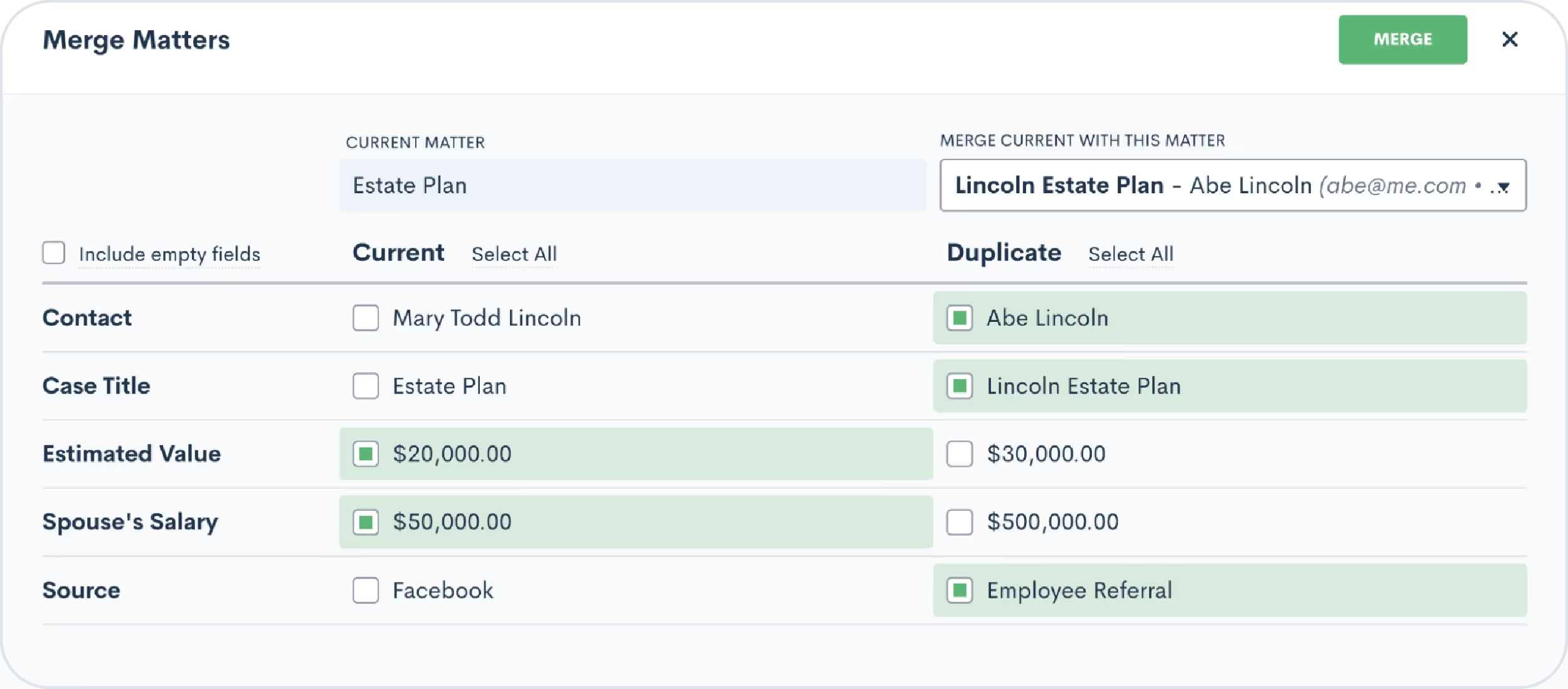
On the heels of our recent Contact Merging feature, you can now easily merge two Matters. If you end up with a duplicate Matter, you can simply click the Merge button on the duplicate Matter to combine the duplicate and original Matter. If there are any conflicting fields, you’ll be able to select which Matter’s data should persist.Driven by user requests, this new feature keeps your pipeline accurate and tidy.Learn more here
Tailor your texts with multiple SMS numbers
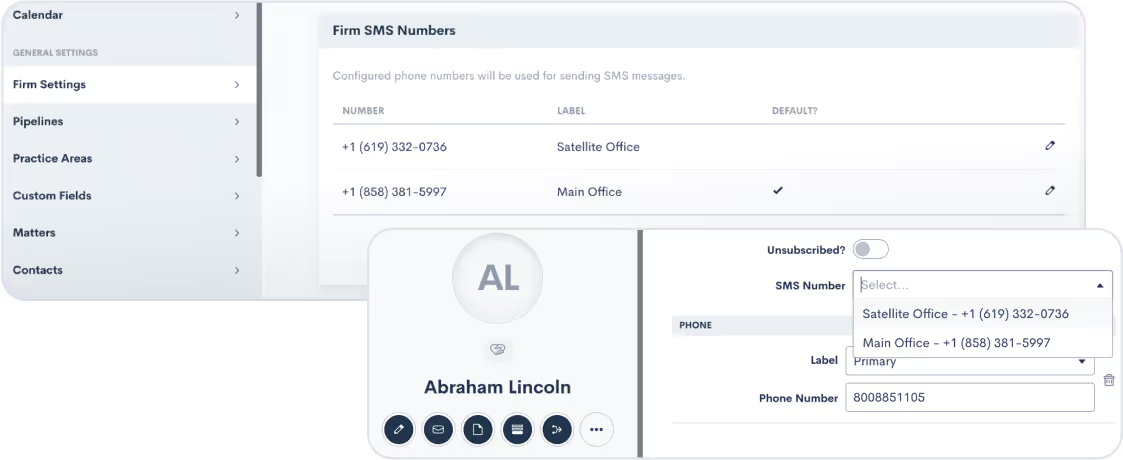
Your firm can now send text messages using multiple phone numbers via Lawmatics. If your firm has a presence in multiple geographical areas, this feature ensures you can reach out to clients with an area code that feels local, trustworthy, and familiar. To activate this feature, simply email us at support@lawmatics.com and let us know what area code(s) you would like to add.* Once enabled, you can start connecting with each client a bit closer to home.*Note: Additional fees apply.Learn more here
And more!
- Leave notes on Contact and Company profiles with the new Notes tab
- Customize your built-in appointment confirmation and reminder emails even further by selecting a user for the emails to send from
- See which user deleted a Matter in your Recovery Bin with new “Deleted By” column
- Rearrange the options in a custom picklist field by dragging and dropping in your Custom Fields settings
Thanks for taking the time to explore our latest feature release! We admire your commitment to staying at the forefront of legal innovation. Rest assured, there's much more in store – and we can't wait to share it with you.
There are more than 40 million lawsuits in the United states alone every year. Yet recent findings from the Rand institute for Civil Justice reveal that only 10% of Americans who have been injured, whether in a car accident, a workplace accident or a result of negligence, file a claim for compensation. And only 2% of those will ultimately proceed with a lawsuit. So who is doing all of this suing?Contract and small claims cases comprise the bulk of the civil caseload, and unfortunately, most of these lawsuits are baseless claims, also known as frivolous lawsuits.According to the US legal system, a frivolous lawsuit is by definition a legal claim with no facts or basis to support it, filed by an entity or individual who is well aware that it has no legal merit. Usually these types of claims are filed specifically for strategic reasons, and often even, dare we say— absurd.Frivolous lawsuits are unfortunately a persistent issue in the legal system, particularly in the US. These trivial claims don't just cost individuals and businesses precious time and resources, but also legal professionals. Despite a handsome settlement amount, it’s hardly enough to make up for the time and energy wasted. What’s more, often these cases are filed with the sole intention of harassment. In other words, they can be a royal pain in the …. for everyone involved.Consider these examples:A person sues a manufacturer claiming that their product caused improbable injuries or damage. For example, claiming emotional distress caused by a scary Halloween mask.An ex wants to get back at their boyfriend and falsely accuses them of violent behavior.An obese customer sues a fast food chain because of the size of their small booths.Like it or not, when these recklessly litigious people come your way you have to be ready for them. In this article, we’ll go over some of the most effective strategies to not only handle frivolous lawsuits but effectively prevent them.
The consequences of frivolous lawsuits
Waste of time and resources
Frivolous lawsuits clog up the court system and increase the backlog of cases that are waiting to be resolved. They slow down the entire legal process resulting in delays for people legitimately seeking justice.These silly lawsuits waste the time of everyone involved and unfortunately divert attention and resources away from cases that actually matter. According to the US financial Education Foundation, each year excessive tort costs add up to well over 500 billion dollars.
Damage to reputation
When someone's name is attached to a frivolous lawsuit it tarnishes their name and reputation. It may even get to the point where the media covers the case which can change public perception of the defendant and negatively impact both personal and professional relationships. Not to mention, it’s costly to defend yourself against a frivolous claim. According to the National Federation of Independent Business, frivolous lawsuit cases cost small companies an average of $100,000 to fight for the integrity of their reputation.Walmart’s reputation has been notoriously tarnished as they receive an average of 20 whopping lawsuits a day, totaling about 5,000 a year. Unlike the average small business, however, they are the world’s largest retailer and have the means to defend themselves.
Legal sanctions and penalties
Defendants may pursue a counterclaim against the plaintiff, and if successful, it could result in legal sanctions and penalties for the party that filed the frivolous lawsuit. Fortunately, the judges are just as frustrated as everyone else when a frivolous lawsuit gets filed. As such, you may have a pretty good chance of turning things around and suing for damages that include the cost you had to pay to defend yourself against a baseless lawsuit.
Remedies for preventing and handling frivolous lawsuits
1Educating clients about the consequences of filing frivolous lawsuits
Although legal professionals are no strangers to frivolous lawsuits, your client may not be. It helps to educate them on the process and explain the potential risks, costs involved and consequences associated with what they plan on filing a claim for.Start with a simple explanation. It helps to break down the concept of what the clear definition of a frivolous lawsuit is, and that the intention behind this lawsuit is often frowned upon and seen as an attempt to intimidate or harass.Highlight all of the negative consequences that could arise, from financial burdens to the amount of time and resources they're looking at to the potential stress they could anticipate. By educating your clients on the total negative impact that frivolous lawsuits have, the more lawyers can do their part to prevent these cases from bogging down the justice system and making room for cases that actually have merit.Lastly, provide them with a breakdown of how much they're looking out for legal costs. From attorney fees to potential damages, it helps them to understand the total financial picture— it’s often hardly worth it.
2Conducting thorough case assessments before filing a lawsuit
Unfortunately, there are lawyers out there who are willing to file a lawsuit that they know to be entirely frivolous. All this does is perpetuate the stereotype that lawyers are crooks. Do your part to promote the integrity of lawyers by conducting thorough case assessments before filing a lawsuit. Evaluate whether the potential lawsuit has any likelihood of success and whether the resources and costs required outweigh the potential benefits.By examining the legal merits of your case you can discourage your clients from pursuing baseless claims and reduce the burden you put on courts and defendants.
3Filing anti-SLAPP motions
A SLAPP lawsuit (short for Strategic Lawsuit Against Public Participation) is a lawsuit filed with the intention of silencing or intimidating an individual or an organization exercising their right to free speech. The objective of a SLAPP lawsuit isn't necessarily to win, but rather to burden the defendant with costly legal fees and stressUsually, these SLAPP lawsuits are fired off by powerful businesses or individuals with the intention of silencing critics or whistleblowers.An anti-SLAPP motion is a legal mechanism designed to protect businesses and individuals from these circumstances and can be a powerful tool for stopping frivolous lawsuits in their tracks.The purpose of an anti-SLAPP motion is to dismiss these lawsuits in the early stages before the defendant risks being burdened with defending themselves against baseless claims.A successful anti-SLAPP motion must prove that the defendant's actions or speech were within their constitutional rights and that the plaintiff’s claims lack merit.If the court determines the defendant meets both of these elements, the motion is granted and the lawsuit is dismissed before it even gets started.
4Seeking attorney's fees and costs
Seeking attorney's fees and costs is an effective strategy to discourage the filing of meritless claims. By demanding compensation for any expenses incurred by the defendant for legal fees and costs you may be able to deter a frivolous lawsuit in its early stages and prevent the abuse of the legal system.
Examples of frivolous lawsuits
Frivolous lawsuits happen every day all over the United States. However, the ones we hear about most are often the most outlandish ones. After all, who hasn't heard of the infamous hot coffee lawsuit of 1992 when a customer sued McDonald's after ordering a hot coffee and spilling it on herself?Here are some other notable lawsuits that have gone down as some of the most frivolous in history.
Man Sues Strip Club For Topless Dancer’s Breasts “Hitting Him like Two Cement Blocks”
In 1996 a groom claimed that an exotic dancer gave him whiplash from her breasts while performing a lap dance on him at his bachelor party.According to the defendant, he was “too embarrassed” to see a doctor for three months. Finally, two years later he was still in pain which is when he sued the club for refusing to pay his medical bills.Luckily, the case was dismissed on the famous television show the People's Court as a judge ruled that the injuries he were claiming to have sustained we're physically impossible based on the size and weight of the defendants breasts.
Michigan Man Sues Anheuser-Busch For “False Advertising”
In the 1990s Budweiser ran a series of commercials which depicted a group of people cracking open a can of Budweiser and magically manifesting a tropical setting with buxom ladies After seeing this commercial, the defendant claimed he purchased a pack of beer only to find that no beaches or babes appeared. He sued Anheuser-Busch for $10,000 claiming it caused emotional distress mental injury and financial loss.Needless to say, the Michigan Court of Appeals dismissed the case based on his failure to state a claim upon which relief could be granted. In other words, the court found that since the dangers of drinking beer are already well known amongst the public, Anheuser Busch was not required to explicitly state the risks in a commercial.
Man Sues Dry Cleaners for 67 Million Dollars For Missing Pants
In 2005 a man named Roy Pearson was just about to start his new job as an administrative judge. After bringing his pants to the dry cleaners, they were lost. The owners of the dry cleaner offered $12,000 for the missing pair of pants, but this wasn't enough for this angry customer. He went on to sue the dry cleaners for a whopping $67 million which included emotional damages, legal fees, and demanded 10 years worth of car rental fees to visit a different dry cleaner. Ultimately, not only did he lose the case but a judge ruled that his litigation tactics were “beyond aggressiveness and crossed the boundary into abusiveness.”Unfortunately, despite winning the case, the dry cleaners were forced to close as a result of the legal bills they had to pay to represent themselves. How could this cases have been prevented from taking up any time in the courts at all? Unfortunately, this was one of those cases that despite the defendant attempting to settle early on, the plaintiff insisted on prolonged litigation. Had the dry cleaners hired an experienced attorney who specializes in frivolous cases, they may have been able to successfully file a motion to dismiss in the early stages of the lawsuit, highlighting the lack of legal basis before reaching trial.
Empower your legal defense against frivolous lawsuits
It's safe to say that frivolous lawsuits burden the legal system. Justice should be accessible to people who have genuine claims, which is why it's important that lawyers are familiar with the best strategies to prevent these cases from reaching trial at all,.From anti-SLAPP mechanisms, to thorough case assessments, lawyers can help individuals and businesses protect themselves with these strategies and prevent clogged up court dockets that cause major delays for legitimate legal disputes.
Picture this: A client is anxiously awaiting an email containing documents they need to sign before a fast-approaching legal deadline. The clock is ticking but that crucial email is lost somewhere in cyberspace or trapped in a spam folder and the window of opportunity is getting smaller with each passing minute. What do you do?
What is email deliverability?
The scenario above is a classic email deliverability nightmare. To better understand what’s going on, let’s back it up a step. You may have heard the term ‘deliverability’ thrown about, but how much do you know about it?At its core, email deliverability is the successful delivery of an email to the intended inbox.But there's a lot that goes on behind the scenes to make this possible. Achieving good deliverability means navigating the intricate dance between technical aspects, such as server configurations and domain reputation, and the nuances of content quality and data cleanliness. Achieving high deliverability is both an art and a science that often requires wearing a lot of different hats.Because of this, we have a dedicated team that is constantly working to make our platform better and support you through resolving tricky deliverability problems. If you’ve ever run into a high bounce rate issue or needed to solve a last-minute missing document mystery, you’ve likely spoken to myself or one of our amazing support specialists.We’re heavily focused on making sure we deliver emails as consistently and reliably as possible for you and your firm. We know that it's not just about sending messages; it's about ensuring they're received and received well.
Why does it matter?
1Essential communication and trust building
Email is a crucial communication channel between your firm and its clients. When important updates or time-sensitive documents don't reach their intended recipient, it's not just a missed connection. It's a lost chance to build trust, display your expertise, and nurture invaluable client relationships.
2Business impact and reputation
A tarnished email reputation can have lasting consequences. In my experience, it can take up to a month (in some cases, even longer) to mend the damage caused by sending emails to an outdated or purchased list. Even accidental missteps can tarnish your firm's overall reputation, diminishing client confidence in the long run and creating logistical headaches.
3Efficiency and productivity
The need to constantly follow up or resend emails isn't merely an inconvenience. It's a drain on your team's productivity, diverting time and resources away from essential tasks, direct client engagement, and achieving a better work-life balance.
4Revenue and engagement
Marketing emails continue to be a major revenue driver for all sorts of businesses and the legal industry is no different. A well-timed email campaign, even a minor one, can significantly boost your firm's ROI. But for maximum impact, it's vital that your emails reach their intended inboxes. Every email that doesn’t reach its intended inbox represents a missed business opportunity.
Guiding principles
There are some key factors that heavily influence how your emails land and your reputation as a sender:
Permission
How do you collect your lists? Having explicit, up-to-date, and verifiable permission from your subscribers is the foundation of good deliverability. It helps build trust while also ensuring that you’re compliant with email regulations and standards. Consider using a double opt-in mechanism whenever possible to reinforce permission and reduce risk, as sending to recipients who haven’t opted in can result in significant consequences for your firm.
List hygiene
How do you make sure that your lists are up-to-date? Email lists naturally decay over time. On average, you should expect around 25% of your email database to degrade each year as people change jobs, abandon old email accounts, or unsubscribe. Maintaining a clean and current email audience helps you avoid problems like high bounce and spam complaint rates.
Engagement
Are you sending to subscribers who are engaged with your content? Engagement rules all in the deliverability world. Different metrics can help provide some insight into who is engaged with your content and lets you know who you should be targeting with your campaigns.We’ll dig deeper into what this means in our next installment, but it’s a good idea to start thinking about these questions if you’re not already.
What’s next?
This series will break down deliverability terms, strategies, and best practices, aiming to help law firms and anyone else interested in effective email communication. Some topics on the horizon include: domain and IP reputation, a deep dive on authentication methods like SPF and DKIM, and how to avoid accidentally spamming your clients. Whether you're a law professional, a marketer, or just someone looking to elevate your email game, stay tuned.Have a question or want to share an experience? We'd love to hear from you! Reach out to us at mail@lawmatics.com.
Bankruptcy law firms face mounting competition and pressure to stand out. With a few dominant players controlling a large share of the bankruptcy market, niche practices must get creative and strategic with their marketing to attract clients and grow their business.This article provides practical tips and techniques to help bankruptcy law firms enhance their efforts across key areas - from understanding the shifting bankruptcy law landscape and changing consumer behaviors to implementing targeted niche marketing leveraging their unique expertise, crafting compelling, unique value propositions, streamlining intake through optimized digital touchpoints and automation, choosing the right digital marketing and advertising platforms to connect with potential clients, and creating data-driven PPC campaigns optimized for ROI.With the right approach, firms can level the playing field, carve out their niche, and boost quality leads. By implementing the strategies outlined in this guide, firms can set themselves apart, improve client conversions, and build a thriving bankruptcy law practice.The insights here aim to empower legal marketers and firms with actionable tips to help them navigate the competitive landscape. Let's dive in and explore how thoughtful positioning, streamlined processes, and calculated digital marketing can drive growth even in a concentrated market.
Understanding the bankruptcy law landscape
The bankruptcy law industry has undergone major shifts in recent years. Changes in bankruptcy legislation, the rise of dominant national firms, and evolving economic conditions have significantly impacted bankruptcy filings and the competitive landscape. As a result, firms must adapt their marketing approach.For instance, recent data indicates that while overall bankruptcy filings decreased in 2021, many bankruptcy practices are preparing for potential liquidity crises as pandemic aid runs out. This unpredictability means firms must stay nimble and adjust their outreach accordingly. Additionally, industry consolidation has resulted in a few prominent law firms holding a majority share of the bankruptcy services market. National powerhouses like Kirkland & Ellis and FTI Consulting handle high-profile restructuring cases across the country.Smaller firms can compete with the dominant national players by tracking market trends and continuously honing their online presence. Standing out requires strategic positioning and optimizing your website and digital marketing, It can be done!
Targeted niche marketing in bankruptcy law
Given the concentrated nature of the industry, niche marketing can provide smaller firms with a competitive edge.Potential clients actively research to find expertise specific to their needs. Targeted search terms like "small business bankruptcy lawyer" or "Chapter 7 bankruptcy help" present lucrative opportunities for firms specializing in these areas.However, niche focus should be balanced with flexibility. Specializing too narrowly could mean missing out on wider opportunities. Firms should determine key practice areas based on their strengths and local market needs. For example, a firm could build a niche in bankruptcy services for restaurants and hospitality businesses, a sector struck by the pandemic. But they also need to serve other struggling companies in their region.The key is in-depth expertise positioning coupled with adaptability. This empowers firms to attract clients seeking specific guidance while also meeting broader market needs.
Crafting a compelling unique value proposition
With few firms dominating the adviser space, clearly communicating what makes your bankruptcy practice unique becomes critical.An effective unique value proposition (UVP) should answer the following:
- Who is your target clientele?
- What specific problems can you help clients solve?
- How does your firm's approach stand out in a crowded market?
The defined UVP should feature prominently across all marketing materials, website pages, and communications platforms. This ensures your differentiating strengths are conveyed consistently to potential clients. A firm could position itself as specializing in personalized Chapter 7 and Chapter 13 bankruptcy protection for consumers and families. Their UVP would then showcase their expertise in navigating personal bankruptcy, their focus on customized debt relief solutions, and a compassionate approach during a vulnerable time.A compelling UVP empowers firms to get precise with their positioning. When underpinned by niche expertise and delivered consistently, a unique value proposition is a cornerstone for standing out even amongst dominant national players.
Streamlining intake for bankruptcy law firms
An efficient and empathetic intake process is a cornerstone of success for bankruptcy law firms. How potential clients are greeted and onboarded during those critical first interactions sets the tone for the relationship. Firms implementing a streamlined, understanding intake approach see higher conversion rates, reduced loss of leads, and improved productivity.
Optimizing digital touchpoints for seamless client acquisition
A law firm's website and online intake platforms are often the first touchpoints for potential clients. An intuitive, easy-to-navigate website and contact page are crucial for connecting with website visitors and capturing leads.Here are some tips for optimizing online intake:
- Simplify contact forms. Remove any unnecessary fields and only gather essential information like name, contact details, and a brief background of their situation. Keep forms short and concise to encourage completion.
- Assure confidentiality. Communicate that user data entered into online forms will be kept fully confidential. This helps provide reassurance, especially when sharing sensitive financial details.
- Mobile optimization. Many users access firm websites from their phones. Ensure forms are mobile-friendly with tap-to-call features, legible fonts, and minimal data fields to quicken completion.
- Live chat functions. Consider adding live chat support on your website to immediately address visitor queries and guide them on the next steps.Payment integration. Allow users to secure partial payments or deposits through your intake forms to begin securing their business.
- Thank You landing pages. After form submission, provide an automated thank you/confirmation page detailing the following steps and contact timelines.
Also, effective call handling requires staff knowledgeable in bankruptcy specifics and can field inquiries accurately yet empathetically. Some best practices include:
- Answering calls quickly and responding to web queries within the hour. This quick response can reassure clients you are reliable, and- remember- if you aren't answering quickly, these potential new clients are calling other law firms.
- Having trained staff well-versed in bankruptcy options who can answer common questions or direct calls properly.
- Collecting only essential information and summarizing the next steps before ending a call. Follow up promptly.
Have the marketing team or firm owner listen to call recordings periodically to monitor quality and identify any areas for improvement to use in training. Call handling is an important touchpoint, so ensuring calls are fielded properly and empathetically is key.
Leverage client portals and tools to automate intake
Automating intake processes through secure client portals can revolutionize client onboarding. These portals allow clients to self-enter their case details and documents seamlessly transferred to the firm's systems. This eliminates tedious manual entry and minimizes errors.Automation enables attorneys to spend less time on administrative tasks and more time crafting a customized legal strategy for clients.But personalization should still be prioritized through:
- Client segmentation to send tailored communications based on case specifics.
- Scheduling follow-ups and check-ins as critical junctures.
- Customized questions or client questionnaires to account for unique situations.
- Adding personal touches to automated emails like name, case details, special instructions, etc.
Optimizing their intake process for firms struggling with bottlenecks in capturing and converting leads can significantly amplify qualified leads, reduce losses, and streamline operations. In an increasingly concentrated market, efficient onboarding processes are imperative for competitive advantage and client retention.
Digital marketing strategies to connect with clients
In today's digital era, embracing online marketing is non-negotiable for bankruptcy firms looking to attract clients and maximize ROI. But with countless platforms and strategies to choose from, it can get overwhelmingly fast.The key is to avoid shotgun approaches and carefully select channels that align with your audience. Meet clients where they already are online. Provide value through educational content that speaks to their pain points. And remember - employ data, not guesswork, to guide your efforts.Let's break down actionable ways modern bankruptcy practices can up their digital marketing game.
Track and optimize marketing efforts with data
They say you can't manage what you don't measure. That's why constantly monitoring and analyzing performance data is crucial for bankruptcy law firms looking to refine their digital marketing strategy. Leverage tools like Google Analytics and Lawmatics to extract key visitor and customer metrics. Review website traffic sources, audience demographics, content engagement, lead conversions, and more.Pay attention to your website's bounce rate, which indicates the percentage of visitors leaving quickly. High bounce rates often mean your content or pages aren't resonating. Test different elements like page layouts, calls-to-action, email subject lines, and ad variations to see what performs best.Essentially, let data guide your marketing decisions - not guesses or assumptions. Look for patterns and insights that reveal opportunities to improve results. Perhaps a landing page isn't converting well, or an ad campaign exceeds your cost-per-acquisition target.Continuous optimization based on real data is the key to cost-effective marketing. Tweak campaigns, allocate budgets to what works, and eliminate what doesn't. The numbers don't lie - so let them direct your strategy to the greatest success.
Establish yourself as a leading authority with a strong online presence
Your law firm's website is the anchor of its marketing strategy and critical for attracting clients. A modern, polished website with compelling content shows you're a credible, tech-savvy firm ready to partner with clients.Ensure your website is mobile responsive, easy to navigate, focused on your unique value proposition, and contains client testimonials that build trust.
Develop a content strategy that shows thought leadership
Alongside a well-designed website, create and distribute content that provides value and establishes your bankruptcy expertise.
- Blog regularly with topics addressing common client concerns and questions.
- Produce engaging content like videos explaining complex processes or podcast interviews with experts.
- Share and repurpose content across platforms - email newsletters, social media posts, and more.
- Make content easily scannable for readers with headers, lists, visuals, and more.
- Promote content consistently to widen your reach over time.
This value-driven content positions your firm as a trusted leader clients can rely on.
Employ SEO best practices for greater discoverability
Leveraging search engine optimization (SEO) helps maximize online visibility and discoverability.On-page optimization
- Target relevant bankruptcy-related keywords in titles, headers, content, etc.
- Craft meta descriptions that engage searchers and boost click-through rates.
- Use proper alt text and image optimizations.
Technical SEO
- Ensure mobile responsiveness and fast site speeds.
- Build quality backlinks from reputed sites to boost domain authority.
- Leverage local SEO and schema markup for better local rankings.
Monitoring search results and traffic sources provides insight to refine SEO efforts further.With an authoritative website, strategic content, and SEO best practices - firms can become the go-to resource clients turn to in times of financial distress.
Social media for bankruptcy law firms: a calculated approach
Every business today needs some presence on social media. It's like a big, shiny "OPEN" sign that says we're here, we're real, and we care about our community. For law firms, especially those in the bankruptcy space, juggling every social media out there feels like a never-ending task. And the truth? Only some platforms may be worth the time and effort, especially when the marketing team is juggling a lot already. While you can be everywhere, why not try to be where it matters most?
Reddit: navigating the communities of shared experiences
Reddit, often termed 'the front page of the internet,' is home to communities discussing almost everything. For those grappling with bankruptcy, subreddits like r/personalfinance and r/smallbusiness become sanctuaries to discuss financial troubles and seek advice.
- Anonymity & empathy: Reddit provides users a veil of relative anonymity, allowing for open discussions about personal financial struggles without the fear of judgment. A law firm can make an impact by participating in these candid discussions.
- Engage & educate: Hosting AMAs (Ask Me Anything sessions) or simply being proactive in answering questions can position a law firm as a supportive entity. It's not about immediate client acquisition but building trust and offering genuine assistance.
TikTok: quick tips in cool clips
TikTok's algorithm, often praised for its precision in content delivery, provides an excellent platform for firms to reach a wider audience.
- Quick informative videos: Start with bite-sized informational clips. For instance, a 30-second video explaining a particular aspect of bankruptcy or a myth-busting session can resonate well.
- Engage & personalize: As the engagement grows, pivot to community-driven content. Answer questions, host quick Q&A sessions, and, most importantly, let the human side of the firm shine through. Clients don't just buy services; they invest in people. Showing off the personality behind the legal facade can create deeper connections.
Leveraging PPC ads to reach motivated clients
Pay-per-click (PPC) advertising allows bankruptcy law firms to connect with potential clients already searching for legal help online. With PPC, you only pay when someone clicks your ad. Well-targeted Google/Bing ads can put the front and center of your service for searchers seeking terms like "file chapter 7" or "debt relief attorney."
Determine potential value and ROI goals
The average bankruptcy case earns a firm $1,250. Lower-quality leads may cost $30-60 each, while high-quality leads run over $200. To determine potential value, estimate your average client lifetime value based on your typical fees. Then establish a target ROI - for example, aiming to earn 50% over your ad spend. If 4 in 10 leads convert to clients, you may need to spend $2,000 in advertising to acquire 4 clients and hit your ROI goal.
Set an optimized budget
Calculate your marketing budget based on target revenue, projected conversion rates, and desired ROI. While the math can get complex, the concept is simple - spend enough on advertising to meet your ROI and revenue goals based on your expected conversion rate.For example, if you aim for $10,000 in revenue and expect a 40% conversion rate based on your historical data, then you estimate you will need 25 leads to achieve that revenue goal (25 leads x 40% conversion rate = 10 clients).If your data shows your cost per lead is around $200, then you would need $5,000 in advertising spend to generate those 25 leads (25 leads x $200 cost per lead = $5,000 in ad spend).This $5,000 spend would achieve your $10,000 revenue goal at a 100% ROI. Any additional conversions above the 40% rate would further increase your ROI.So, in summary:
- Define your revenue goal.
- Estimate conversion % based on data.
- Calculate the number of leads needed to achieve the revenue goal at that conversion rate.
- Determine the ad spend required to generate those leads based on cost per lead.
Tools to track performance
Analytics like Google Ads and Google Analytics provide data on clicks, conversions, costs, and ROIs. Review frequently, and make data-driven decisions to optimize efforts. Improve performing ads and pause less effective ones.
The power of optimized PPC
With the right messaging, targeting, bids, budget, and optimization, PPC flexibly fills the gaps around organic traffic and builds your client pipeline. Treat it as an investment into your firm's growth and revenue.
The road ahead - ongoing optimization for bankruptcy firms
More than just driving leads, marketing done right builds trust and lasting client relationships. So regularly test new platforms and strategies - but keep a firm handle on ROI. Measure data and double down on what works. Be willing to pivot away from poor performers.While great marketing brings in clients, an efficient intake process truly sets firms apart. From user-friendly web forms to compassionate call handling, ensure each touchpoint makes clients feel understood and supported. Automate intelligently to scale operations without losing personalization.The best marketing and intake processes work hand in hand. Firms willing to test new approaches, focus on ROI, and optimize based on data will gain a competitive advantage. They'll forge genuine connections with clients while positioning themselves for sustainable growth.To learn more about streamlining your bankruptcy marketing and intake processes, contact Lawmatics for a demo. Our dedicated team can help firms modernize client acquisition and onboarding.
In today's digital age, having a strong social media presence is crucial for any law firm. However, building a following can be challenging, especially for those new to social media marketing. In this blog post, we will share practical strategies and tips for gaining your next 1000 social media followers for your law firm, helping you to increase your online visibility and ultimately grow your business.
1 Limit your platforms
Sometimes, less can be more. While it might seem counterintuitive to scale down the number of channels you market your firm to increase your following, when you’re trying to operate too many accounts at once, you’re likely not giving any of them enough time and attention. There aren’t enough hours in the day for a busy law firm to run a comprehensive outreach campaign on every platform. However, you can attain greater engagement and higher quality leads by concentrating on a few accounts frequented by your target market.
2 Create awareness
More people would likely be interested in your firm’s social media profiles if they knew about them. Spread awareness by including links to social media profiles on your firm’s website, promotional materials, and attorney review sites. But don’t discount word of mouth – inform your clients and fellow professionals that your firm is active on social media and show them how to find you. Because you already have an existing relationship with these individuals, it’s more likely that they will want to check out your content.
3 Be proactive
Don’t wait for your audience to find you. Instead, go looking. Many social media platforms offer a myriad of opportunities to grow your network. LinkedIn and Facebook groups can be an effective way to reach potential clients, industry peers, and your local legal community. Twitter and Instagram enable firms to follow hashtags and terms related to their practice areas. Once you find others interested in your content, engage with them by liking and commenting on their posts or resharing their content to give them a reason to check out your firm’s profile. They might follow you and retain your services if they like what they see.
4 Sound like a human
Although the power of AI is now on many people’s minds, people still want to talk to other people, not machines. Social media can be the perfect way to humanize your law firm, but you must avoid sounding like a robot. Don’t be afraid to keep things somewhat casual. Try to come across as a real person (or a team comprised of real people), not just a nameless, faceless law firm. When you sound like a human, you will build trust and make users feel more comfortable reaching out to you or your firm.
5 Include visuals
No matter how important what you have to say may be, it won’t matter if no one sees it. You have to catch people’s attention with visuals. Several studies have found that visual content gets more engagement:
- Social media posts featuring images receive 650 percent more engagement than text-only posts.
- Around 65 percent of people are visual learners.
- Visual content is 40 times more likely to be shared across social media.
Based on this information, you should integrate photos, graphics, and videos into your content strategy as often as possible.
6 Provide value
You must provide valuable content if you want your target audience to engage with you. Determine who you’re trying to connect with, their preferred communication style, and what legal issues they need help solving. Once you know who you’re trying to talk to, offer helpful content they’ll appreciate so that they’ll be more likely to engage with your posts and spread the word by resharing your content in their own networks.
7 Promote thought leaders and influencers
The legal industry is filled with thought leaders, some of whom might be practicing in your firm. Offering readers a chance to hear from them can generate much interest and increase your following. Influencer marketing also provides a powerful platform for law firms that want to increase their following. Credible influencers in the legal industry can significantly expand your reach, introduce you to new audiences, dramatically impact your firm’s reputation, and help you gain followers. If you notice a legal influencer with an active social media presence, engage with them and discuss how you might collaborate.
8 Mix it up
Various types of content can be helpful for different purposes, platforms, and audiences. To maximize your reach, create a social media content plan where you use each content type a few times, and then take note of what works best. Here are some suggested content types for specific platforms:
- Facebook: Reels, videos, multiple photo posts, and stories
- Instagram: Reels, videos, carousel posts, stories, interactive polls, and quizzes
- LinkedIn: Posts, newsletters, videos, multiple photo posts, polls, and event posts
- Twitter: videos/GIFs, polls, threads, retweeted tweets, and quote tweets
9 Polish your social listening skills
Social media is not just a way to have interactive conversations. In addition, it’s an opportunity to use social listening to understand your audience’s sentiments about your firm and its reputation. With social media, you can gain insights that will help you create and promote content - you can join conversations to connect with your audience, get feedback, and modify your strategies as necessary. Social listening tools can monitor interactions, discussions, and audiences.
10 Personalize your conversations
Today’s social media users are savvy and demand personalized experiences tailored to them and their interests. Research has found that people are much more likely to do business with law firms with whom they feel a personal connection. Therefore, personalizing your social media interactions and other communications with users is an excellent way to encourage a feeling of connection. So, before you reply to a commenter, conduct some research on them and use their name in your comment or mention relevant information you’ve read about them.
11 Maximize hashtags
A law firm’s social media strategy isn’t complete without a hashtag strategy. These symbols (#) have become the basis of any effective social strategy. Hashtags work on almost every social media platform and help you expand your reach to connect with people who do not follow you directly. However, not all hashtags are created equal. Many are oversaturated, have a small following, or aren’t niche enough for your practice. To avoid wasting time with ineffective hashtags, research which ones resonate with your audience, Create a comprehensive list of these hashtags, and use a mix of hashtags in each post.
12 Be part of a community
Smaller communities are increasingly important within large social networks. Whether you join LinkedIn Groups or Twitter Communities, social media communities provide many opportunities to connect with like-minded people and companies within your practice area. Look for communities related to the legal industry on the platforms where your firm is active and start actively participating. You can also start your own groups to cultivate an audience of people who share your interests.
13 Track performance
To improve your firm’s social strategy over the long term, you must constantly monitor what’s working and what isn’t by tracking and measuring your social media marketing performance over time. Use a third-party social media analytics tool or the built-in analytics feature of each social media platform to get detailed insights into your social media traffic.
14 Automate your efforts
With regard to social media engagement, when you post can be just as critical as what you post. All platforms have varying times when users are more likely to be active. To determine when to post, vary your schedule to include different parts of the day to decide whether specific times result in superior engagement. When you schedule posts so they’re ready to go at the right time, your content will naturally get more views.With Lawmatics, you can automate the leg work of your social media marketing efforts to drive growth while staying focused on clients. Lawmatics ensures you and your staff can account for every detail about a lead or client’s journey. Plus, you’ll be able to use your CRM data to trigger the next marketing step and track and analyze the results with built-in analytics and reporting tools. Ready to learn more? Request a demo today.
Effective communication lies at the heart of every successful law practice. From providing timely updates to ensuring seamless collaboration, staying connected with clients is a must. While email can be a necessity, text and Portal messages can take direct and customized communication to the next level.That's why we're excited to delve into the realms of texting and Portal messaging, and unveil our brand new Message Center that's set to transform how you engage with clients.
SMS text messaging
Text messages are delivered (and usually read) almost instantly, making them a fantastic tool for communicating with your prospects and clients. Most people have their cell phones with them 24/7, and often view texts with much more frequency and urgency than emails.Lawmatics empowers your firm to send and receive text messages right from your CRM. When following SMS best practices, texting can result in an excellent client experience and increased conversion rate while also making things easier for your team.
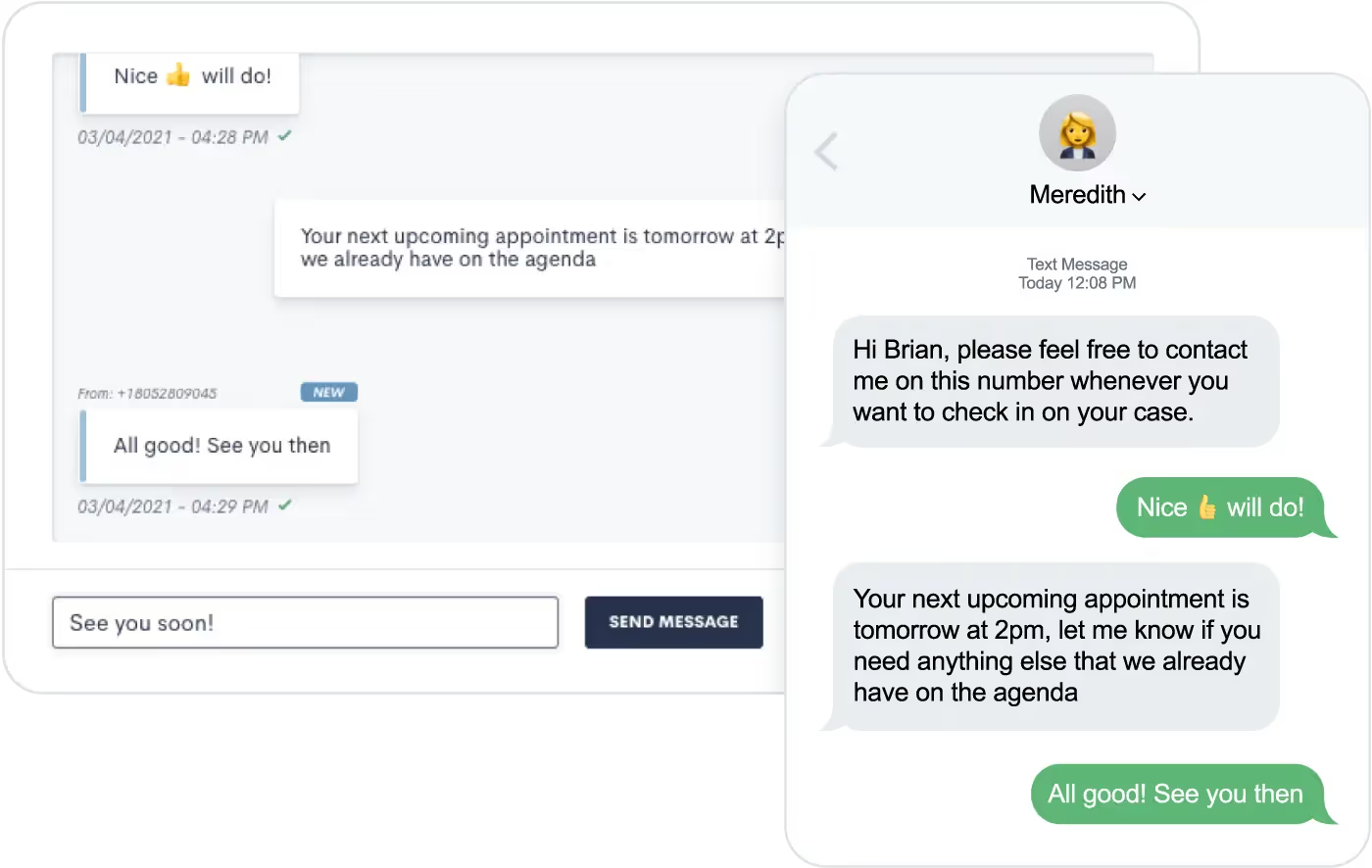
Text messages sent via Lawmatics will not come from your firm’s phone number. Instead, they’ll send from a randomly generated phone number with the area code of your choosing. This number will remain the same so clients will be able to save it as a contact in their phone.At this time Lawmatics offers SMS (short message service) texting, but not MMS (multimedia message service) texting. SMS allows you to send text-only messages, which can include hyperlinks. This means that you cannot share images or other media via text message.If you aren’t using Lawmatics for texting yet, feel free to email us at support@lawmatics.com to get started with this feature. Simply share your firm’s zip code and our team will activate a texting phone number for your account with no additional charge. (Note: only U.S. phone numbers available at this time.)
Automating text messages
You might choose to send texts instead of emails for client communication, or you may use a combination of both. Lawmatics makes it easy to send templated text messages directly from your automated workflows.To send an automated text message:
- Navigate to your Automations page
- Create an Automation
- Select the Send SMS action item
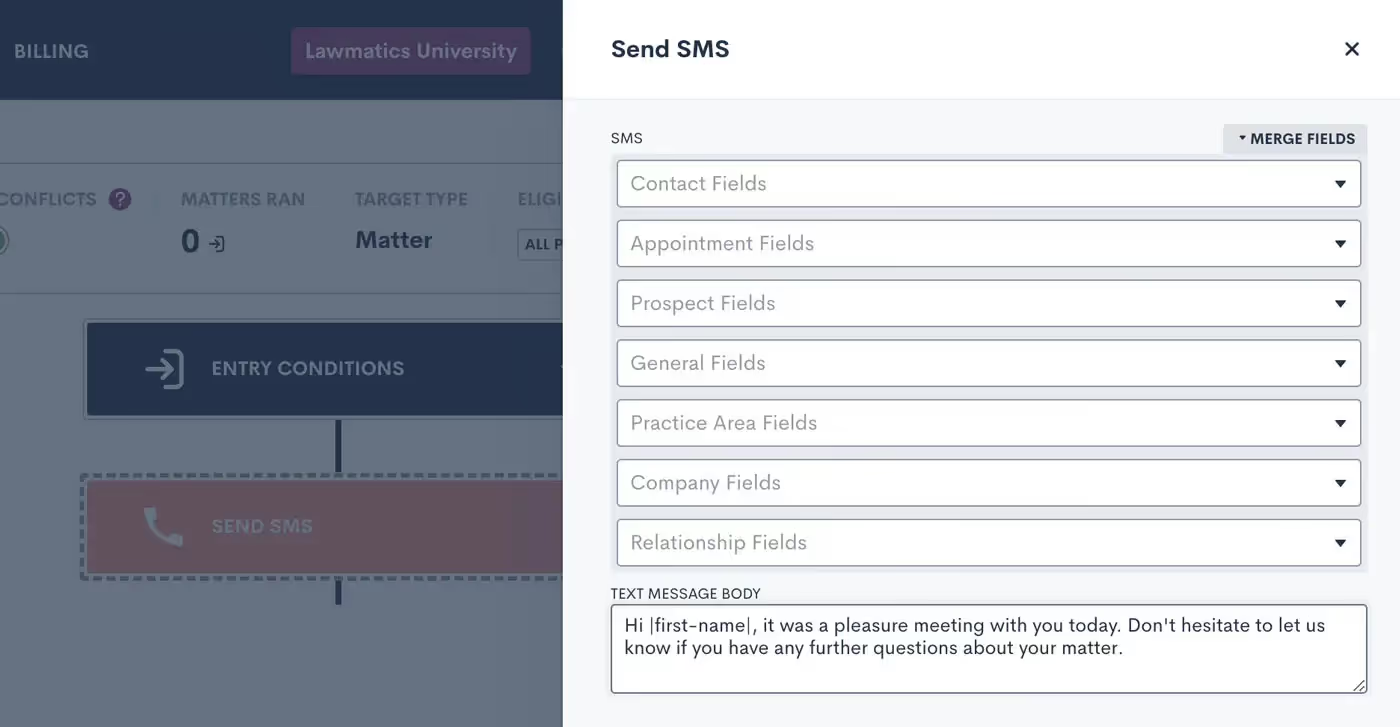
When composing your text message body, as shown above, you’re encouraged to use Merge Fields to address the recipient by name and include any other pertinent information, such as appointment time or other Matter-specific details. This text will function as a template, with each specific target’s information merged in if and when they run through this Automation.When writing your text message template, you also have the option to skip sending the text if the target doesn’t have a valid phone number saved on their Contact in Lawmatics. Enable this selection to avoid causing a failed Automation due to an absent phone number. The workflow will just skip the text and proceed with the rest of your Automation.

Above, you’ll see the Skip toggle as well as the option to set a Delivery Window. Whenever you are using automated text messages, it’s best practice to set a Delivery Window to make sure texts are sent at a time when they are most likely to be seen (and to prevent your texts from sending at inappropriate times).In addition to the Send SMS action item, you also have the option to send many of your assets as a text and/or email. For example, when sending a Form via Automation you’ll see the option to Send as Text or Send as Email.
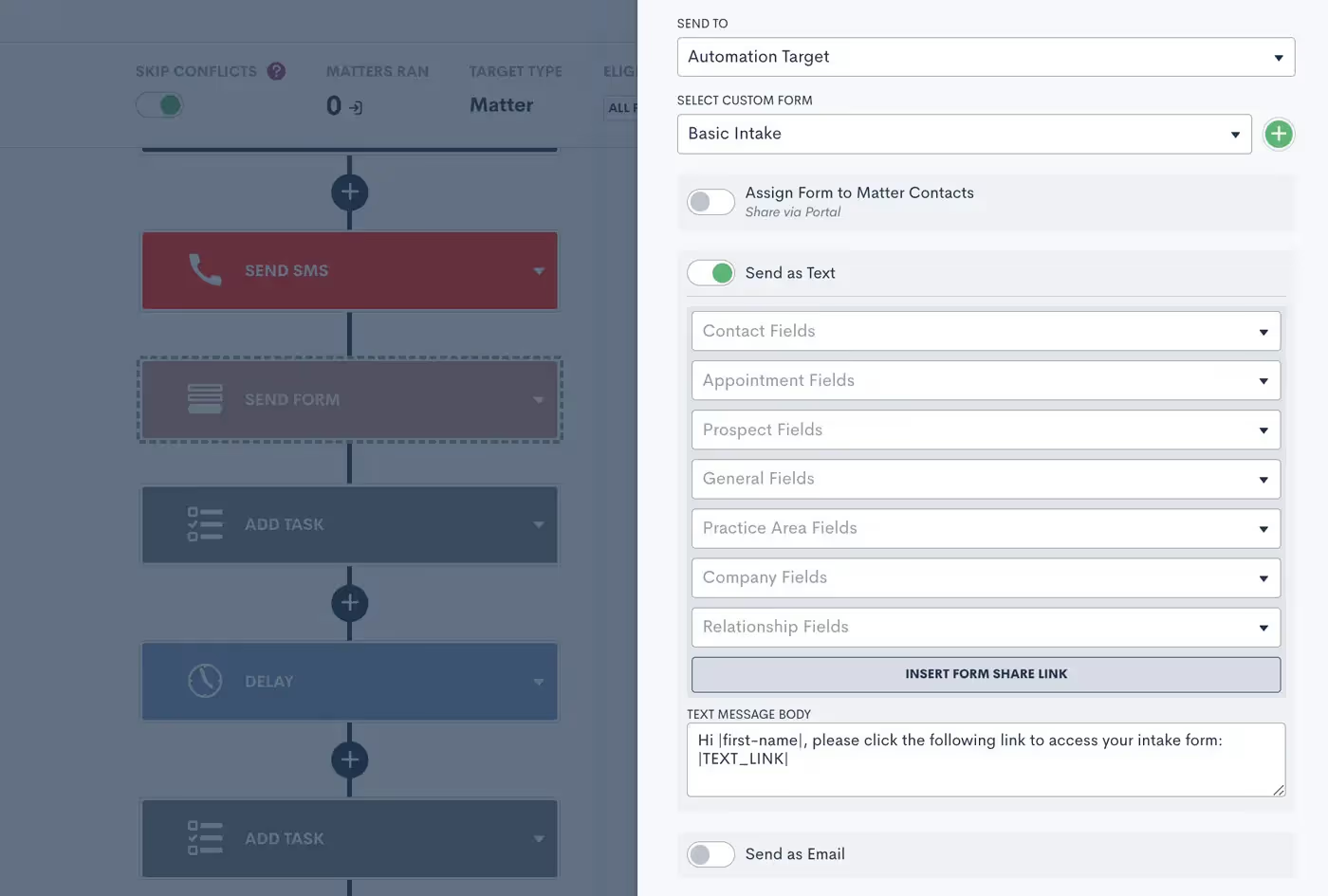
When sending an asset as a text, you’ll still have the option to create your custom text message body template using Merge Fields.In addition to forms, this also works for automated documents, e-signature requests, appointment requests, and more.
Two-way texting
Now that you know how to send automated text templates, let’s dive into our optional two-way texting add-on. This feature allows you to engage in back-and-forth text message exchanges right from Lawmatics. It also gives you the ability to initiate a one-off text to a client rather than relying solely on automated templates.Whether or not you opt for two-way texting, we suggest turning on your email notification for SMS Received in your Settings page.

Without the two-way texting add-on, this notification will let you know that someone has responded to an automated text. You can then call, email, or manually text them from outside of Lawmatics.With two-way texting — in addition to receiving this notification — you’ll be able to engage with the conversation directly from the appropriate Matter (and the new Message Center) in Lawmatics.
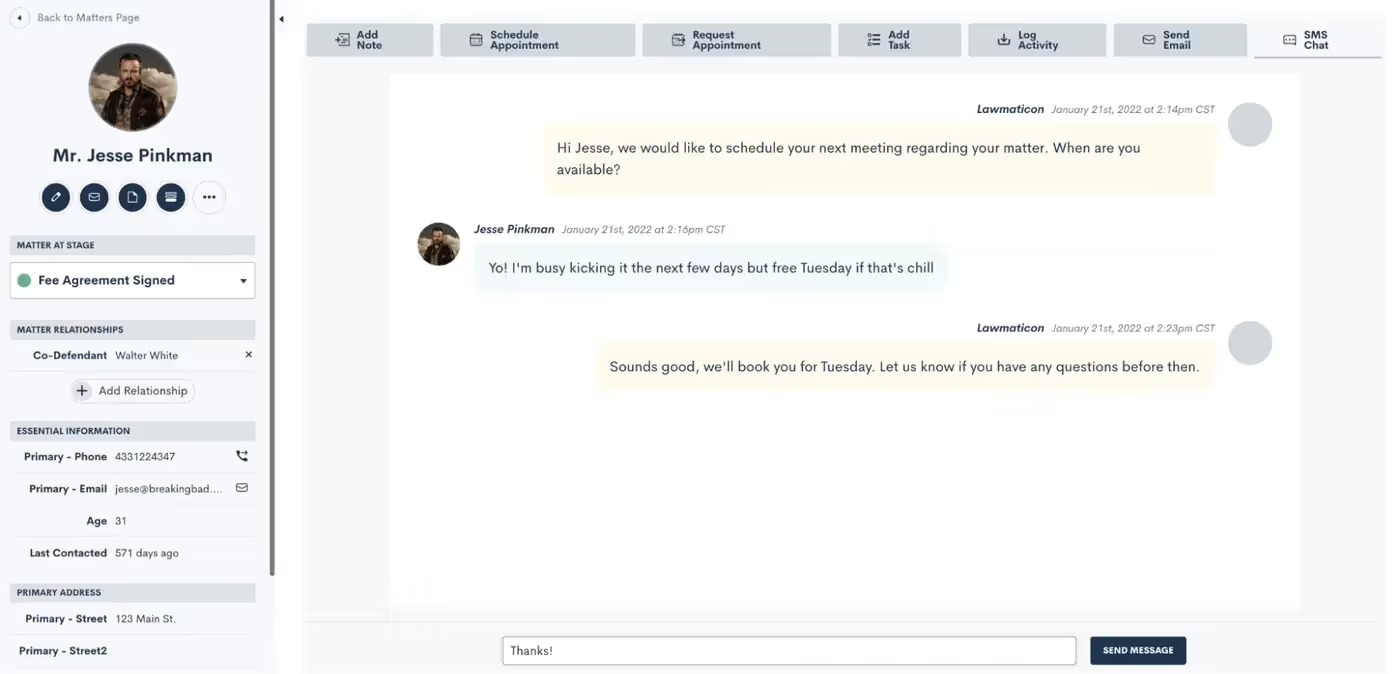
For firms with two-way texting, all text message threads are saved on the SMS Chat tab found on the Matter’s profile.
Client Portal Messaging
In addition to text messaging, Lawmatics also has a messaging function within our Client Portal. (If you’re not yet familiar with the Client Portal, review our past Deep Dive session to learn all the ins and outs of using the Portal.)The Portal is a powerful tool that lets your clients login to view their Matter details such as Forms, Appointments, Documents, and, of course, messages.Remember that you can invite Contacts to the Portal either via Automation…
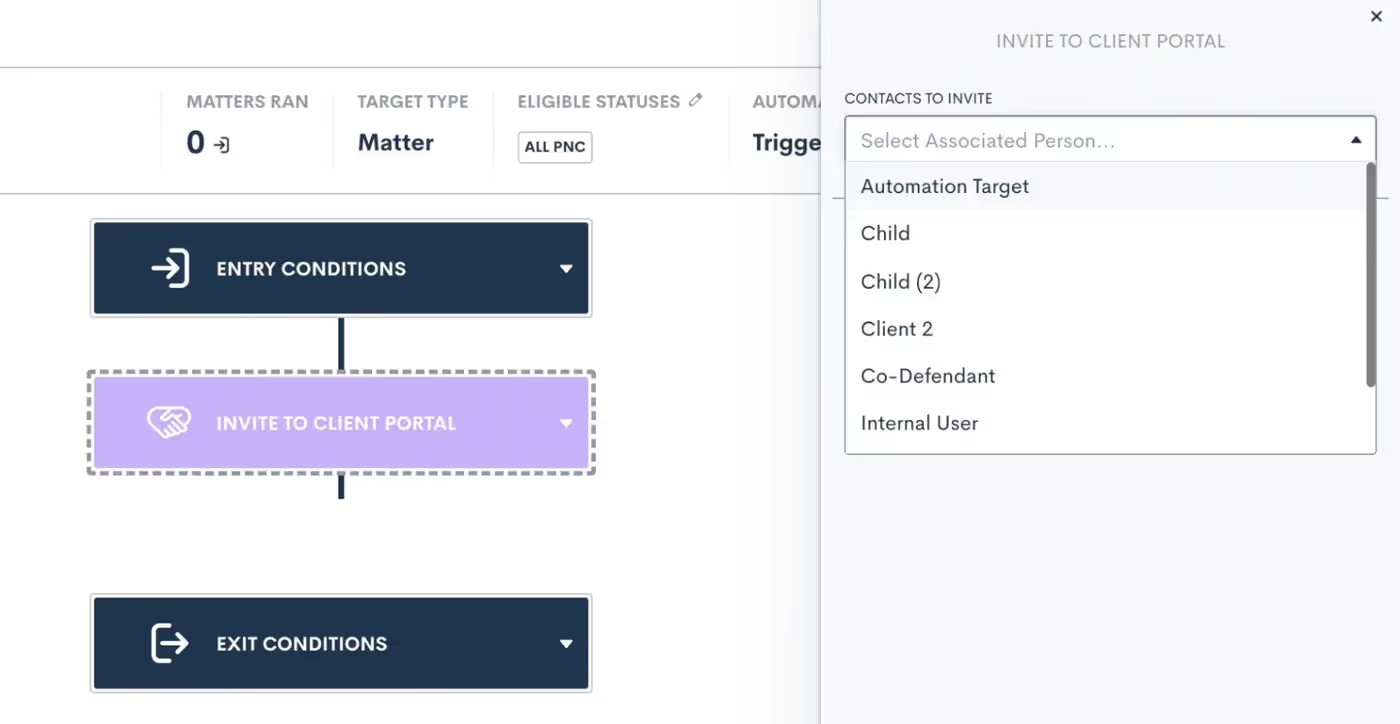
…or by manually clicking the Portal button on their Matter profile:
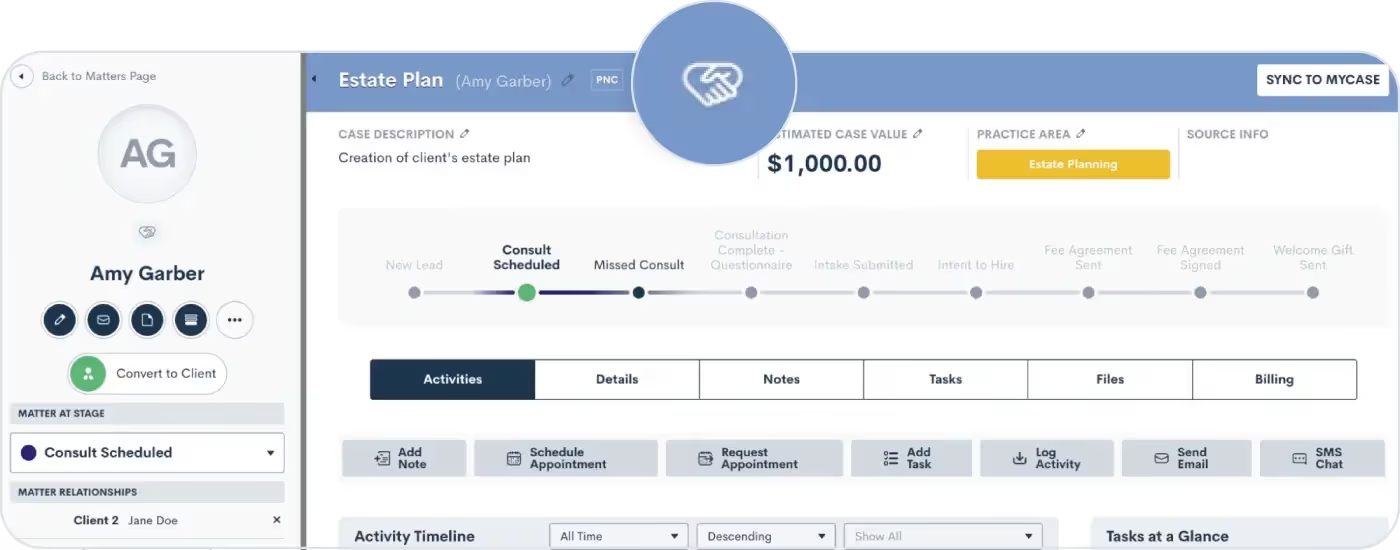
Once a Contact has been invited to the Portal, you can then share any important items with them via Portal, including messages.
Portal Messaging 101
Use our Portal messaging feature to send a message directly into a client's Portal. They can easily view it within their Portal and reply if needed.Unlike our SMS Texting feature, Portal messages do not send to the recipient’s phone as a text message. Rather they can only be viewed within the client’s Portal, as shown below.
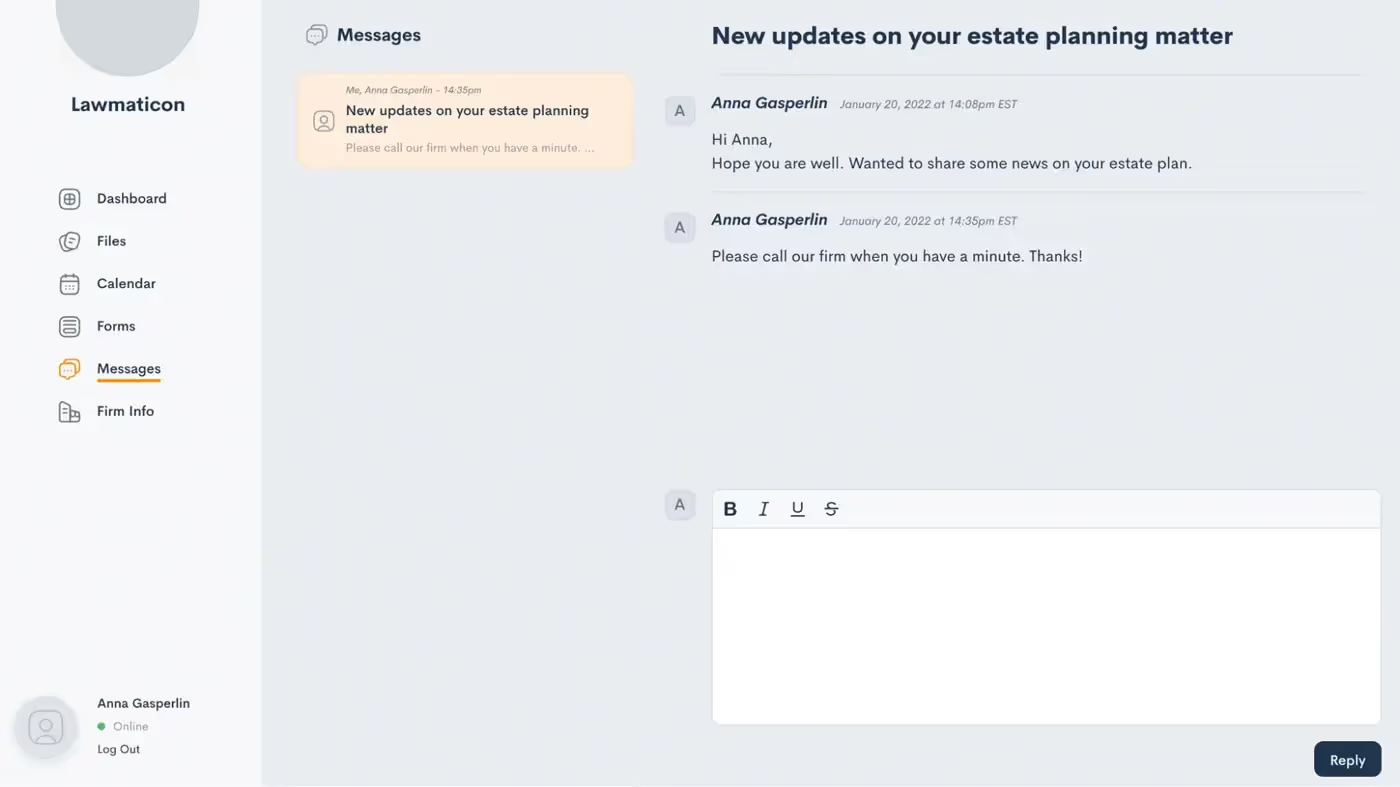
This can be a great option for clients who don’t use texting, opt out of text messages, or just prefer to be more hands off when it comes to their Matter.Previously, Portal messages could be viewed on their own designated page under the CRM tab in Lawmatics. They can now be found in our brand new Message Center.
Introducing the Message Center
The Message Center is your new hub for viewing both SMS text messages and Portal messages across your whole firm. With this powerful feature, staying connected with your clients has never been more seamless.Let’s set off on a guided tour of the Lawmatics Message Center, demonstrating how it centralizes all client communications into a single organized space.To access the Message Center:
- Hover your mouse on the CRM tab near the top left of your screen
- Click Message Center
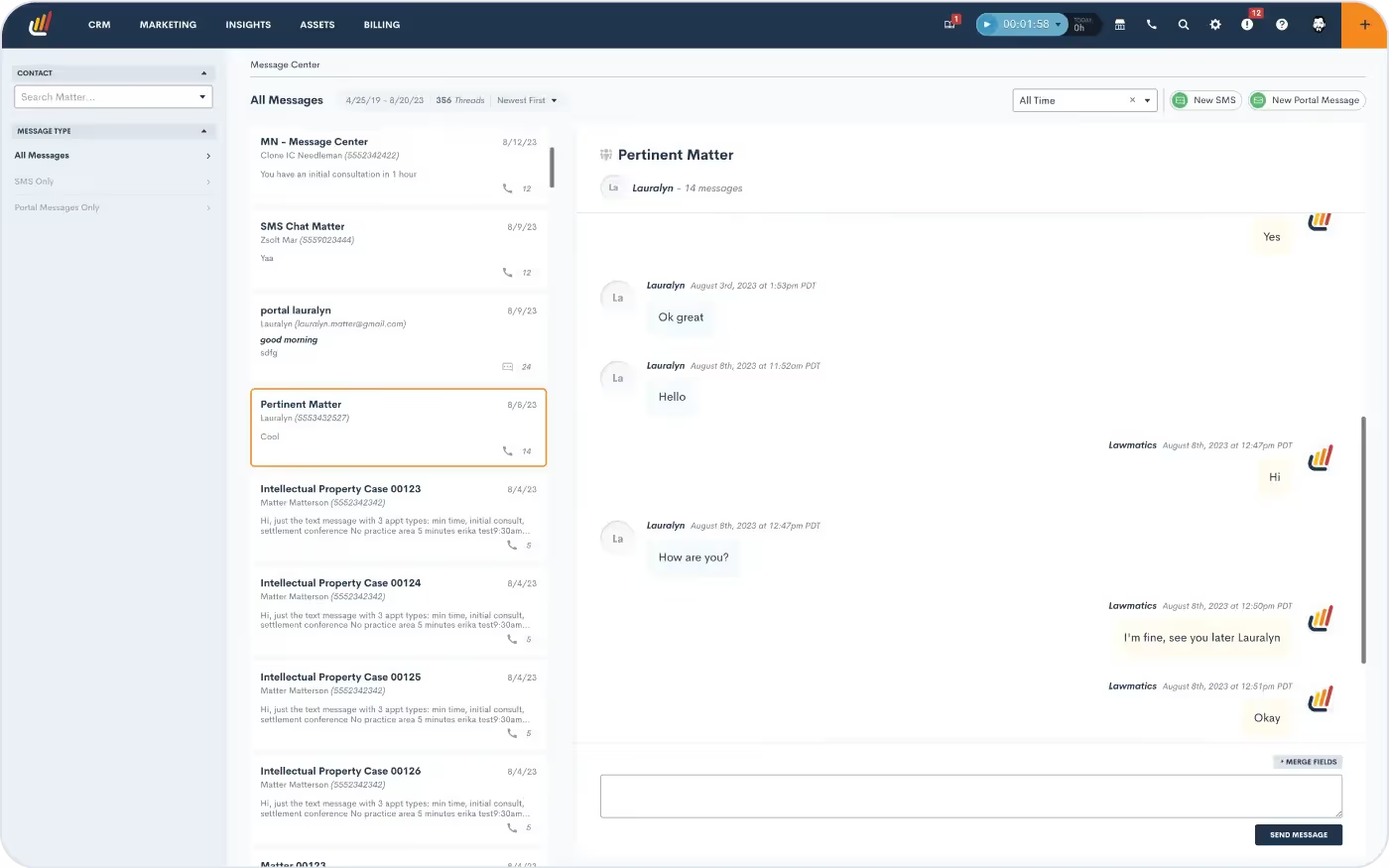
Here you will see a dashboard of all of your firm's messages with clients, tailored to your user's specific access level (read more below about setting users’ access levels).If your firm is using the Client Portal, you’ll be able to view all messages sent and received via the Portal. Note that you can use the button at the top right to create a new Portal message.You can also manage SMS text messages via the Message Center. All text messages sent via Lawmatics will be visible here. If your firm utilizes two-way texting, then you’ll also see message threads exchanged between your firm and the client.
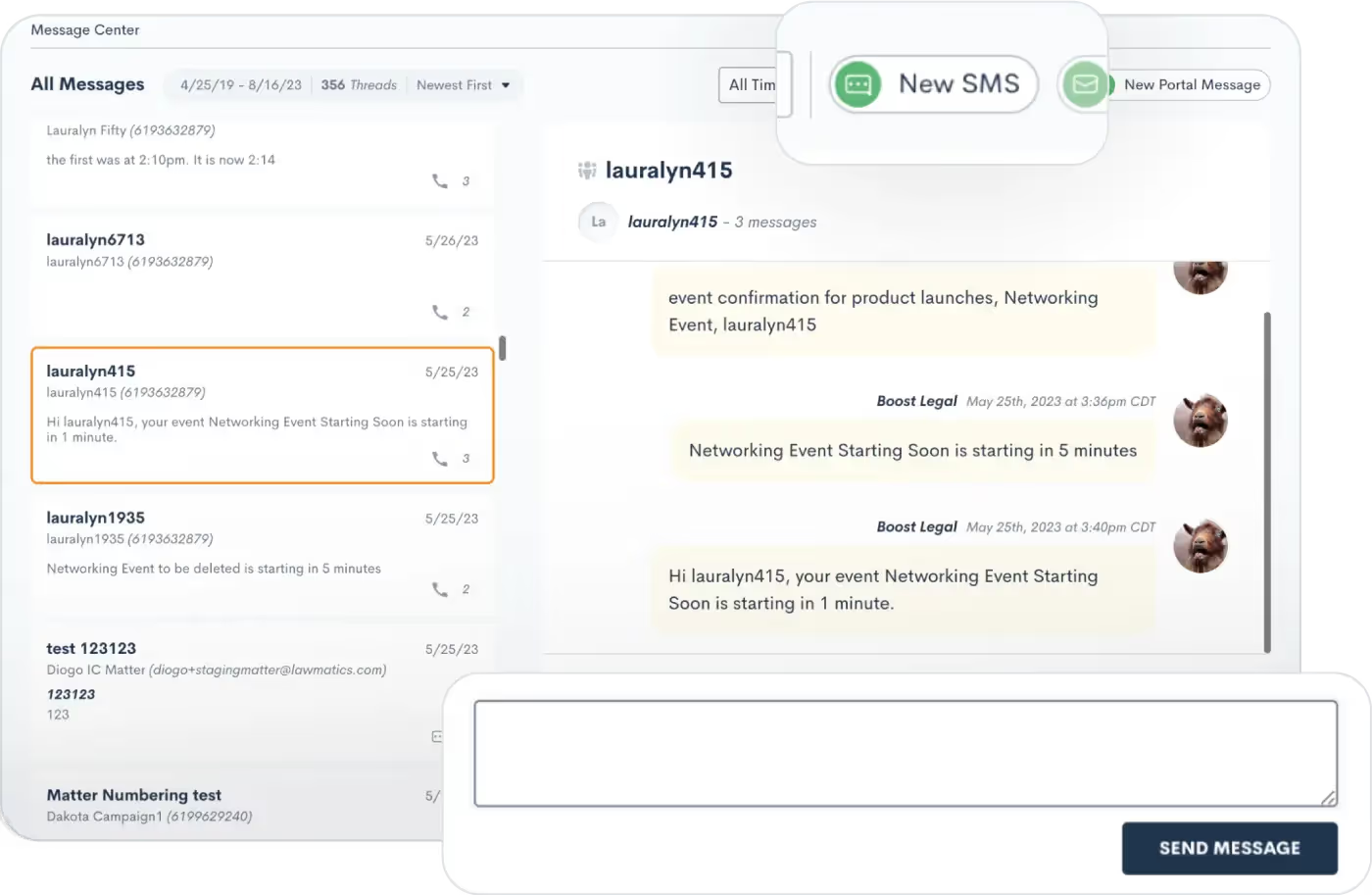
With two-way texting you’ll also have the ability to send out new text messages and reply to threads from the Message Center.
User viewing permissions
As mentioned briefly above, your firm's various users will only be able to view messages in the Message Center for Matters that they have access to. Each firm’s admin will define user roles on the User Management page in Settings.
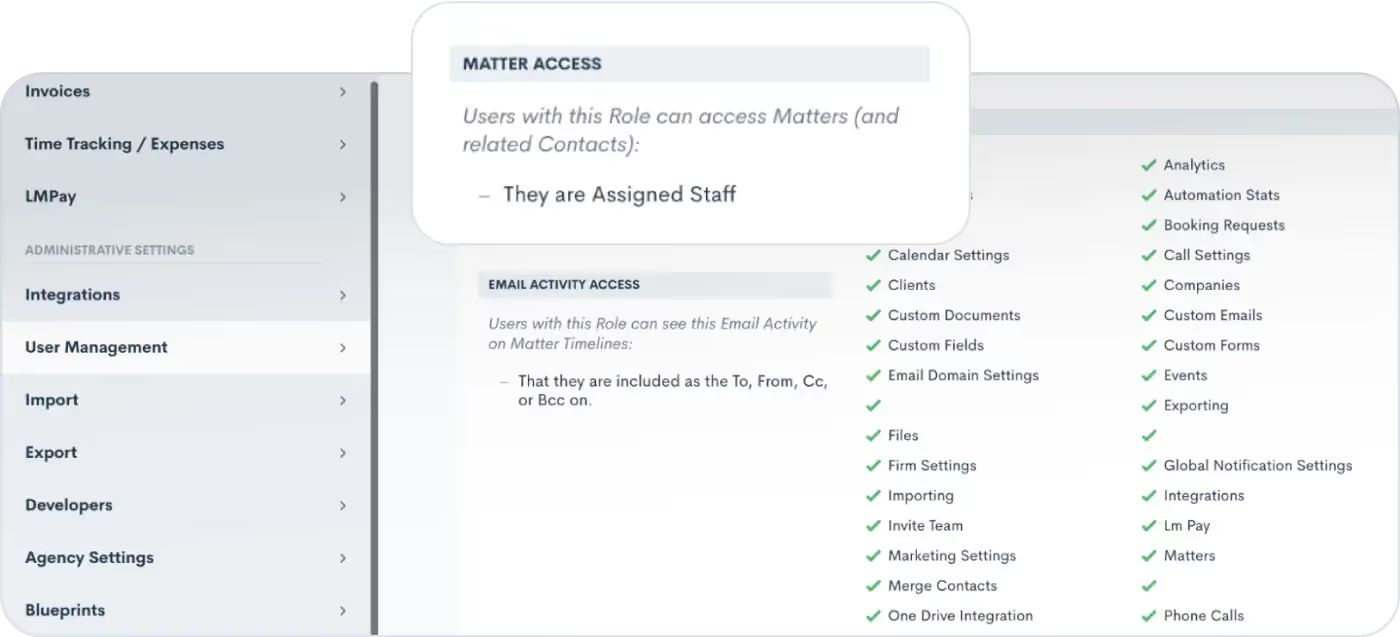
When editing your roles, you can choose the Matter Access level for each role, highlighted above.Whether you have chosen to give certain users access to only Matters that they own, created, etc, or if you wish to give them access to all Matters, this selection will also be reflected in their viewing capabilities for the Message Center. Any user roles that have been granted access to all Matters will be able to view messages exchanged with all Matters in the Message Center.
Filtering and sorting messages
By default, each user will see all messages for Matters that they have access to. However, the left sidebar of the Message Center provides options for filtering messages. You can use this menu to view only:
- SMS messages
- Portal messages
- Messages for one particular Contact
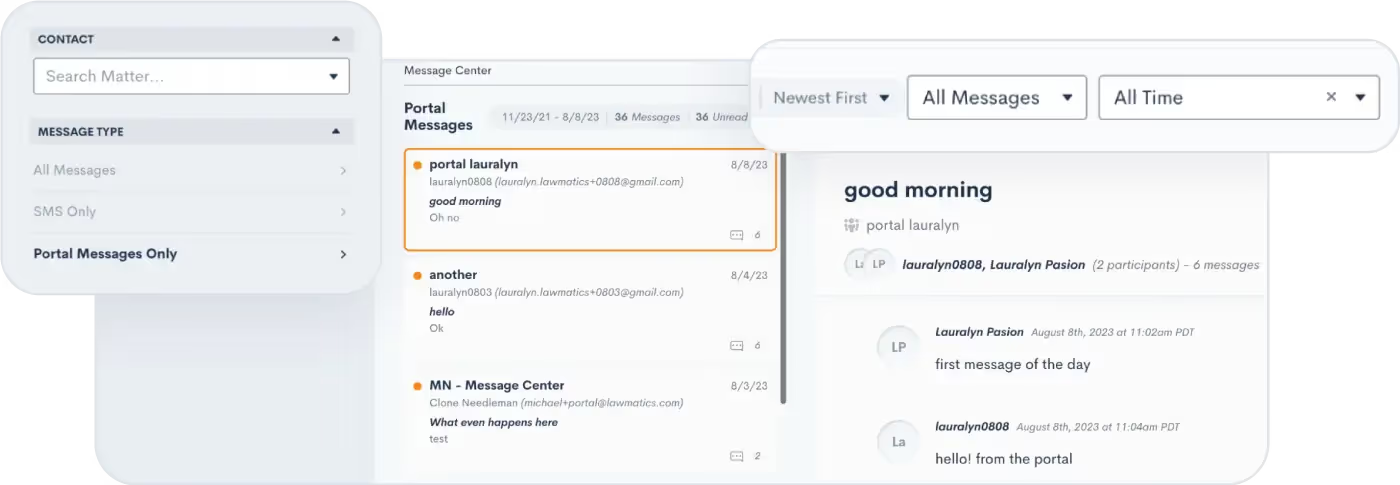
The options on the top right will filter messages by date or message status (i.e. unread vs. read), as well as sort your messages by either newest or oldest first.
Conclusion
As you navigate the landscape of client messaging and communications, know that you are not alone. Lawmatics is here to help you maximize benefits of text messaging and Portal interactions, including the innovative capabilities of our new Message Center feature.As you adopt this new feature, brace yourselves for streamlined communication strategies that can take your law firm's client relations to unprecedented heights.Get started with the Message Center today to dive in and discover the latest tools from Lawmatics that are reshaping the future of client communication in the legal world.
Subscribe to get our best content in your inbox
Ready to grow your law firm with Lawmatics?
Schedule a demo of legal’s most trusted growth platform.
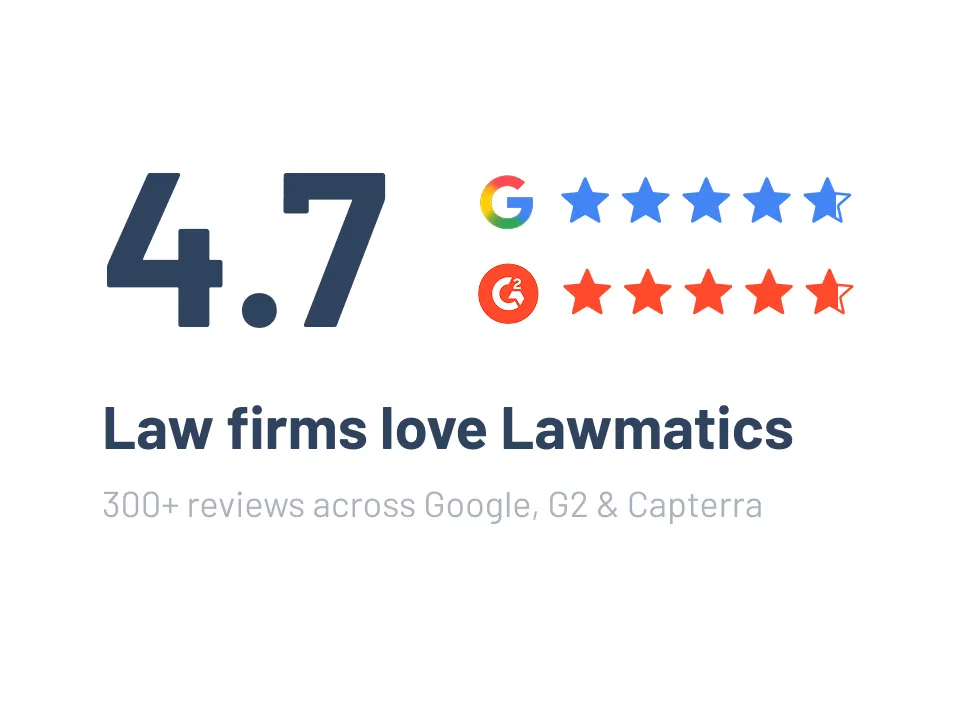




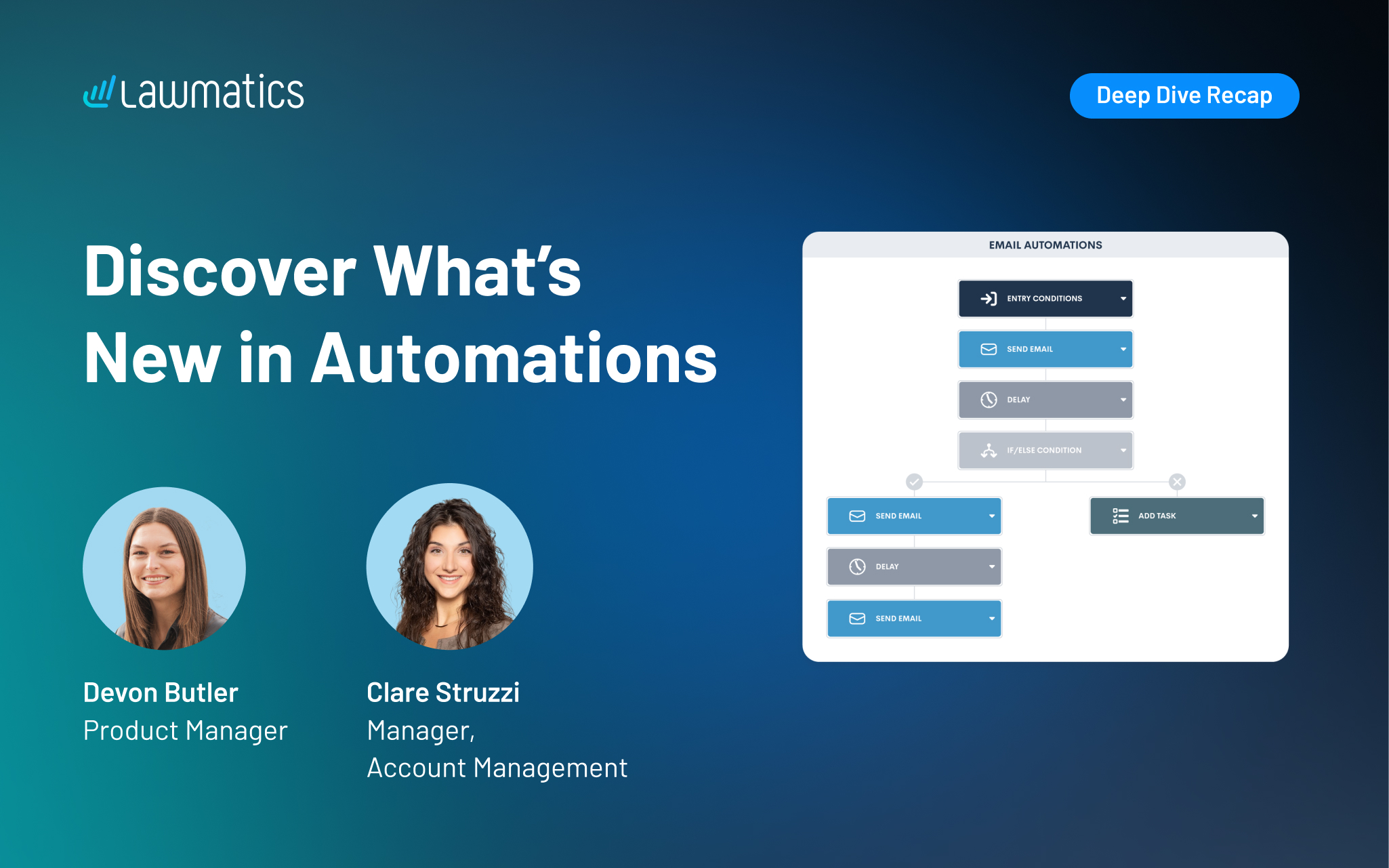



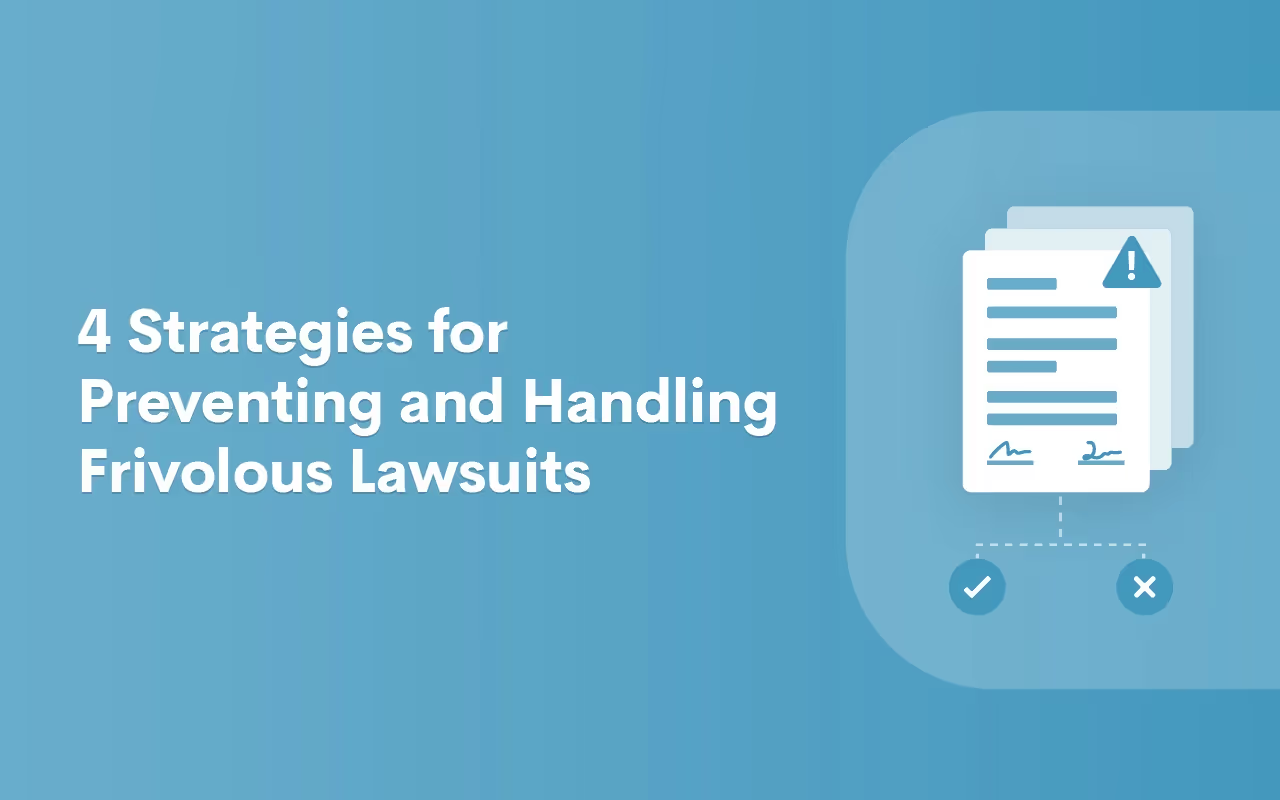
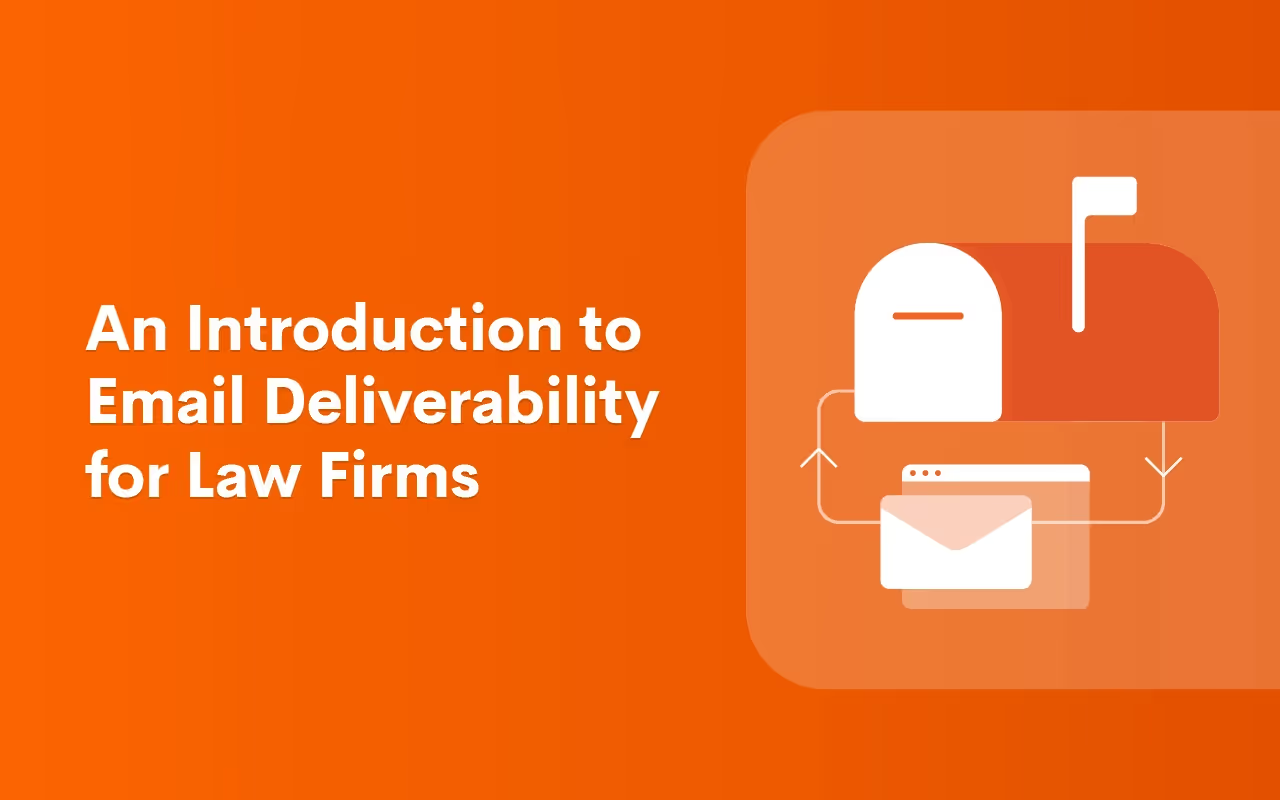
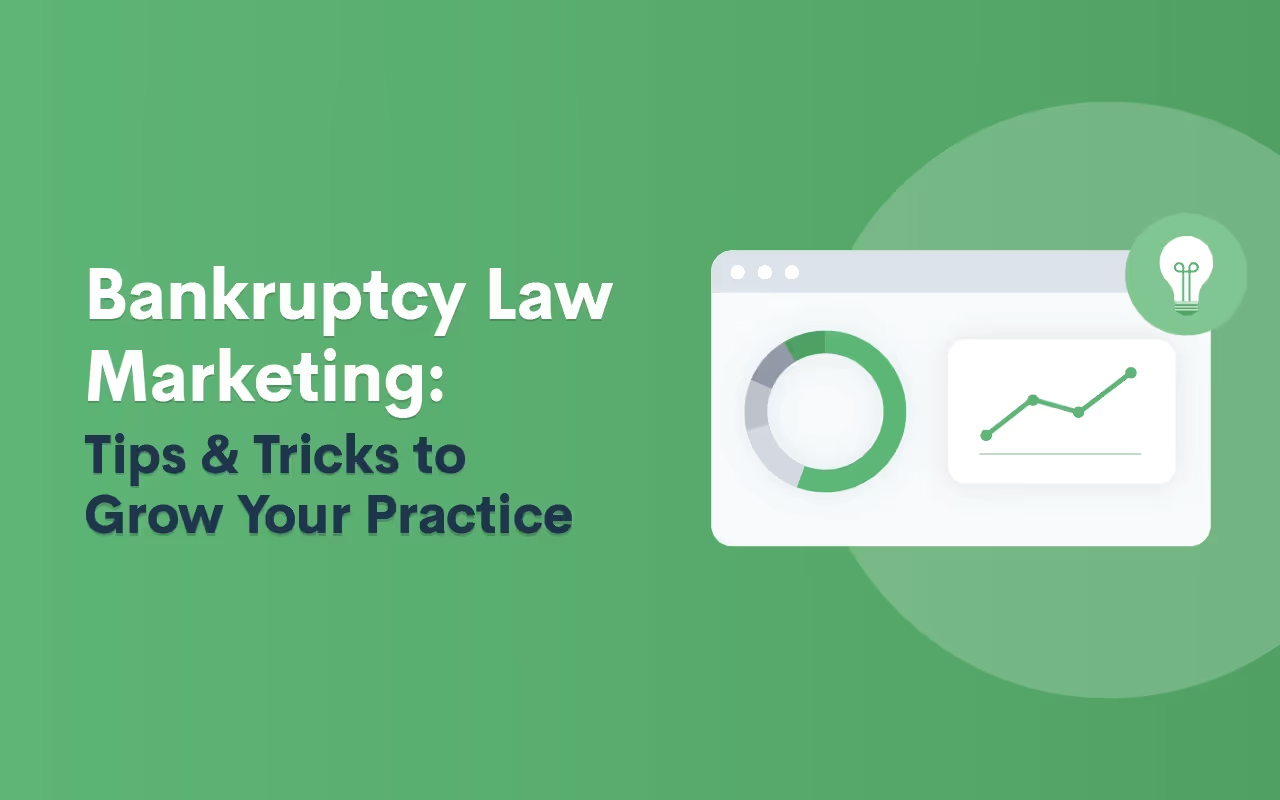
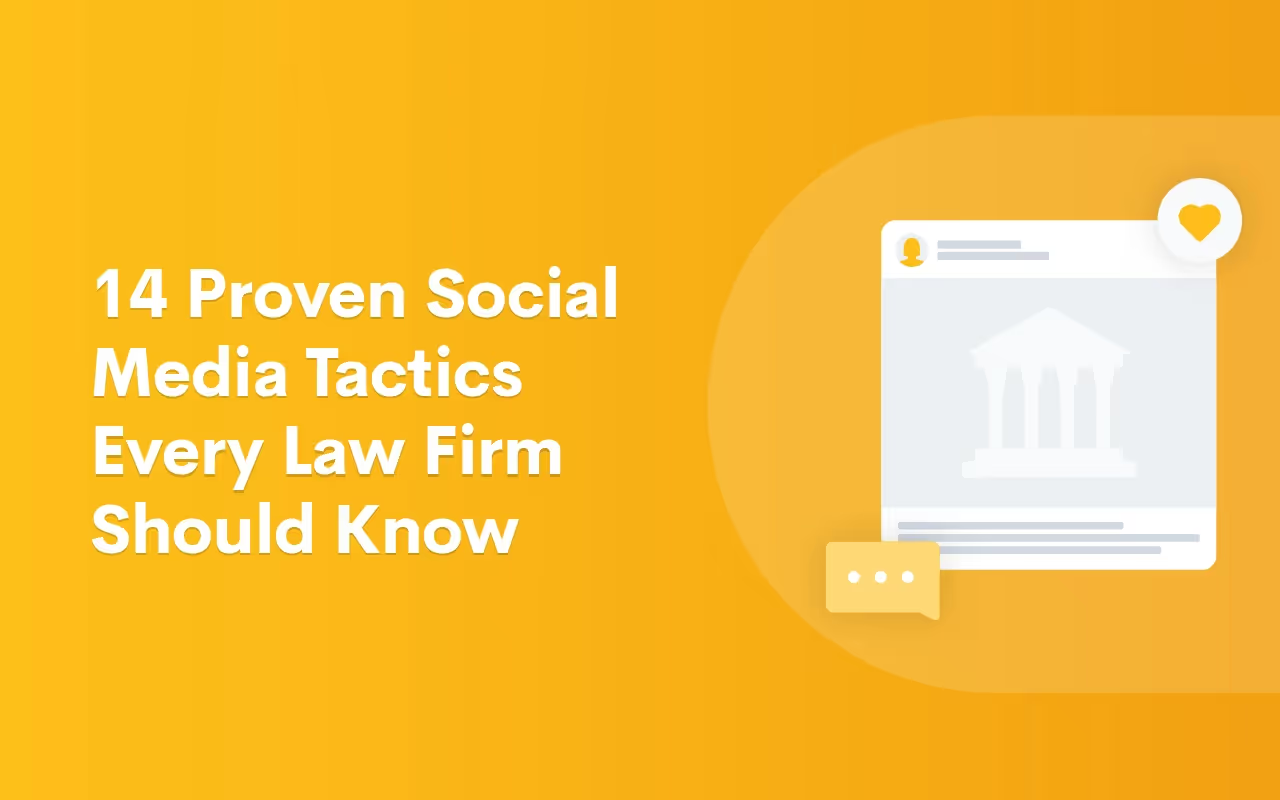
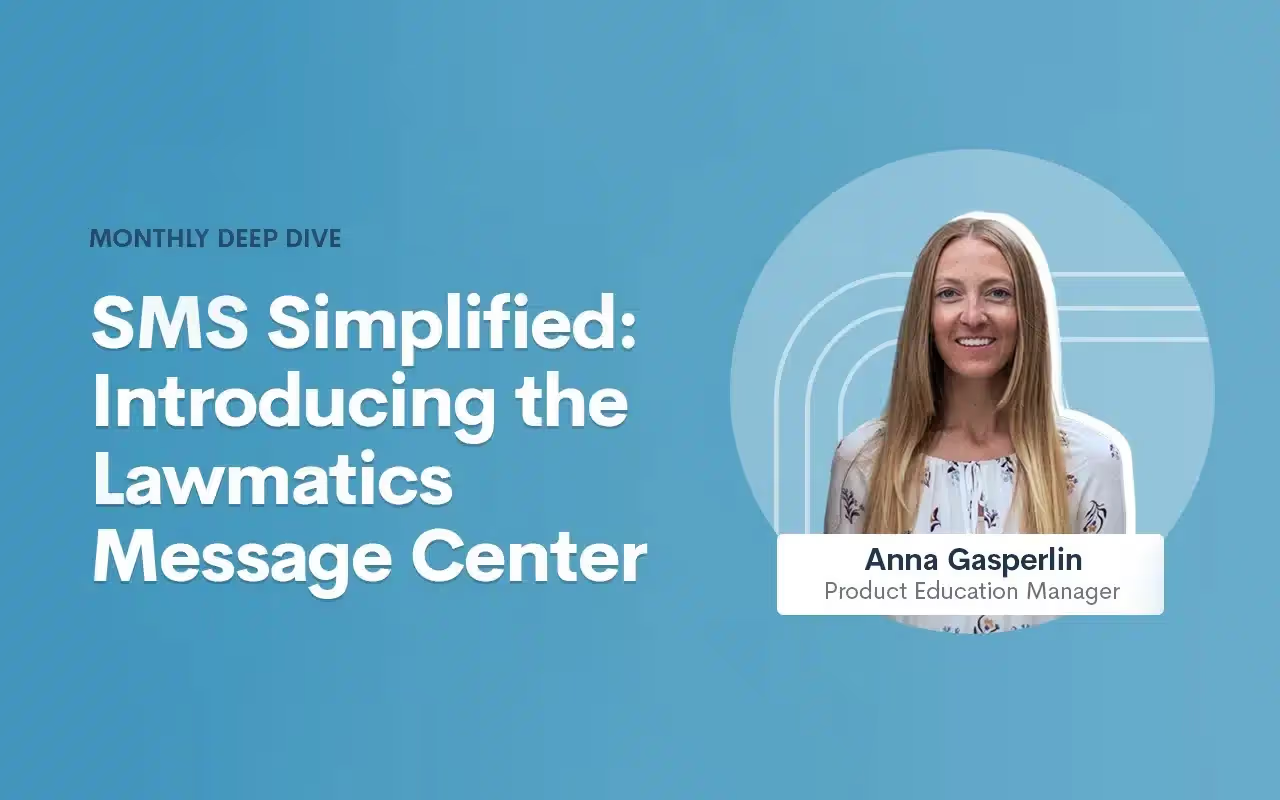
.avif)
.avif)

.avif)
